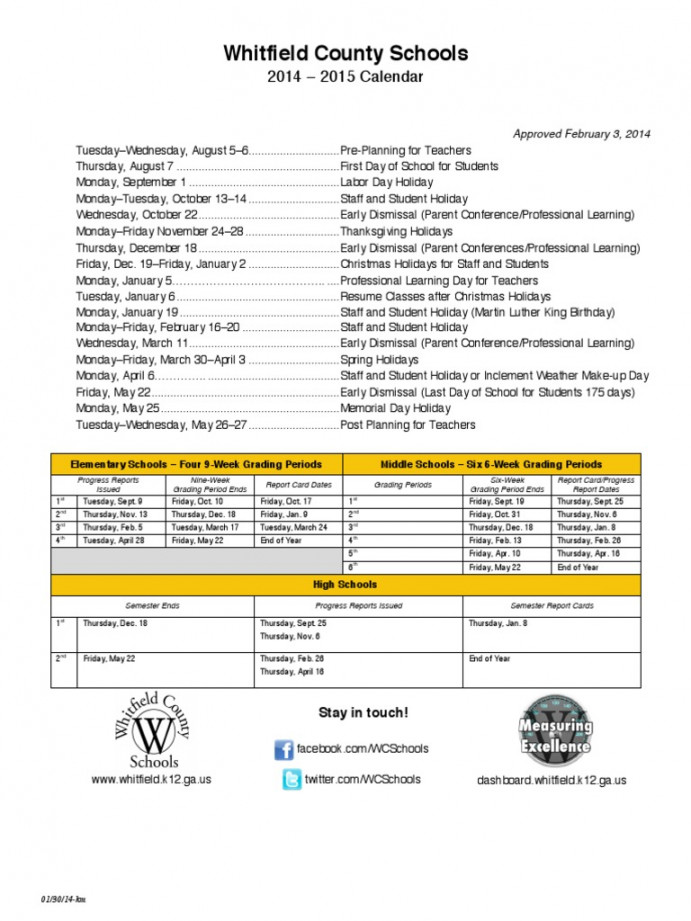Whitfield County Schools Ga Calendar
Content area scores up, graduation rate down for Whitfield County Schools
Jan. 11—Whitfield County Schools (WCS) Director of Accountability and Assessment Michelle Caldwell provided an overview of the district’s 2023 College and Career Readiness Performance Index (CCRPI) during a school board meeting on Monday.

Caldwell noted “this is the U.S. Department of Ed(ucation’s) accountability piece that gets pushed down to states, and the states create their own measures. Keep in mind these measures are very heavily weighted on end-of-growth tests, which are for the middle schools, and end-of-course exams for the high schools.”
Caldwell outlined changes for the 2023 CCRPI.

“Last year was our benchmark, baseline data for this year,” she said, saying how the COVID-19 pandemic had sent baseline data “awry.”
“For 2023, the overall single score was eliminated,” she said. “In the past, we were given a final (overall score), such as an 88 B, and each school was ranked as such. The state asked for permission to take that away, because they thought that was the best way to look at it and I think we would all agree. Each of those components are important, but an overall rating just leaves a lot to interpret, both good and bad. So, the overall score is gone and there will be single component scores (measured from) zero to 100, and that’s what we’re going to look at.”
Content scores
WCS currently has 12,897 students enrolled, with district demographics showing a population of 49% white, 44.9% Hispanic and 71.8% of students economically disadvantaged; the latter is derived from free-and-reduced lunch form data.
“Our component score for content mastery, which is for grades six through 12 … indicates that there was an improvement from last year’s score to this year,” Caldwell said.
The content mastery component, which looks at whether students are meeting the necessary levels in preparation for the next grade, college or career, includes subject scores from Georgia Milestones testing and the Georgia Alternative Assessment 2.0. WCS elementary schools scored 62.5% in content mastery, middle schools 63.6% and high schools 62.2%.
“In the content area scores, you can see which content areas students are actually tested on,” said Caldwell. “In elementary, social studies was taken away. That was part of the governor’s (decision) to take reduced testing for our kids. Social studies comes back in middle school and stays in high school.”
For 2023, elementary schools saw overall improvement in English language arts (ELA) and mathematics, while middle schools improved across the board in ELA, mathematics, science and social studies. High schools saw an improvement in biology and U.S. history, but saw decreases in algebra and American literature.
Progress
Progress scores focus on the growth that students demonstrate within three indicators: ELA, mathematics and English as a second language (ESL) student progress toward English proficiency. Middle school students scored 86.9%, six percentage points higher than the state average, while elementary school and high school students scored 78.6% and 67.5%, respectively.
Within the “progress toward English language proficiency,” elementary schools scored a 100%.
“And you’ll see that kind of fall off in middle and high,” said Caldwell. “We’ve had lots of discussions around that, some of them being that sometimes those (students) love that support so much that they’re not trying to get out. The other piece is that a lot of times, once they get to middle and high, there are some other things that show up that are not just language-based. But as you can see, there are strong, good things happening there for our kids in elementary.”
Closing Gaps
Elementary and middle schools also saw a sizable improvement in the Closing Gaps component, which is represented by improvement flags and sets the expectation for students and student subgroups to make improvements in achievement rates in each subject.
“Closing Gaps breaks it down into each of our subgroups, and of course you want to see mostly green (flags) in this situation,” Caldwell noted. “If you are green and you have a star, that means that you met your subgroup target, plus went (an additional) 3% higher. Yellow means a subgroup made progress, so they’re growing, but they didn’t necessarily meet the target that they were supposed to meet.”
A red flag indicates no growth.
“Middle school, I’m going to have to brag on because you see a lot of green,” Caldwell said.
Middle school students in the economically disadvantaged, English learners and students with disability subgroups scored 3% higher than the target goal in ELA, mathematics and social studies.
“We see really good things happening from elementary building strong foundations that are really paying off in middle school,” Caldwell said. “The curriculum folks and instructional coaches have done some really good work.”
The majority of high school students scored above the target goal in biology and U.S. history, but failed to reach the target for American literature and algebra.
“With American lit(erature) and algebra in red, we know we have some work to do there,” Caldwell said.
Readiness
The readiness component measures whether students are participating in activities that prepare them for the next level and includes indicators such as at or above grade-level reading, student attendance and beyond the core for elementary and middle school students and pathway completion and college/career readiness indicators for high-schoolers.
Elementary and middle schools improved above state level, with elementary students achieving a score of 85% and middle school students 84%. High school students had a score of 66.3%; the state average was 71.4%.
“Looking at their own grade level, we’re above reading, student attendance and beyond the core,” Caldwell said. “There are a couple of other things that come into play for high school, but on this indicator we’ve got two (elementary and middle) in green, so that’s good.”
Attendance and graduation rates
In attendance, elementary schools scored 85.57%, middle schools 82.51% and high schools 75.89%.
“Attendance has taken a hit,” said Caldwell. “Long ago, we were at 95% attendance, which was good. But life has changed … and when we looked at the state average we’re not the only ones struggling in the attendance area. After COVID, it’s been difficult to get some of the older kids to come back to school, but we’re moving, and high schools have done a lot with attendance. It does look like it’s not great, but in comparison we’re doing better than the state.”
WCS had a 3.7% decrease in its four-year graduation rate, but saw an increase in the five-year graduation rate at 89.44%.
“We are down just a little bit there,” said Caldwell. “Our five-year rate went up, but overall we were down from the year before.”